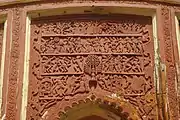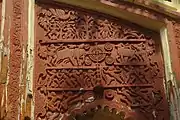Dihi Baliharpur
Dihi Baliharpur is a village in the Daspur I CD block in the Ghatal subdivision of the Paschim Medinipur district in the state of West Bengal, India.
Dihi Baliharpur | |
|---|---|
Village | |
 Dihi Baliharpur Location in West Bengal, India  Dihi Baliharpur Dihi Baliharpur (India) | |
| Coordinates: 22.6073°N 87.7356°E | |
| Country | |
| State | West Bengal |
| District | Paschim Medinipur |
| Population (2011) | |
| • Total | 867 |
| Languages | |
| • Official | Bengali, English |
| Time zone | UTC+5:30 (IST) |
| PIN | 721211 |
| Telephone/STD code | 03225 |
| Lok Sabha constituency | Ghatal |
| Vidhan Sabha constituency | Daspur |
| Website | paschimmedinipur |
Geography
| Cities and towns in Ghatal subdivision of Paschim Medinipur district M: municipal city/ town, R: rural/ urban centre, H: historical/ religious centre Owing to space constraints in the small map, the actual locations in a larger map may vary slightly |
Location
Dihi Baliharpur is located at 22.6073°N 87.7356°E.
Area overview
Ishwar Chandra Vidyasagar, scholar, social reformer and a key figure of the Bengal Renaissance, was born at Birsingha on 26 September 1820.[1][2]
Ghatal subdivision, shown in the map alongside, has alluvial soils. Around 85% of the total cultivated area is cropped more than once.[3]It has a density of population of 1,099 per km2, but being a small subdivision only a little over a fifth of the people in the district reside in this subdivision. 14.33% of the population lives in urban areas and 86.67% lives in the rural areas.[4]
Note: The map alongside presents some of the notable locations in the subdivision. All places marked in the map are linked in the larger full screen map.
Demographics
According to the 2011 Census of India, Dihi Baliharpur had a total population of 867, of which 456 (53%) were males and 411 (47%) were females. There were 93 persons in the age range of 0–6 years. The total number of literate persons in Dihi Baliharpur was 698 (90.18% of the population over 6 years).[5]
Culture
David J. McCutchion mentions the Dihi Baliharpur temple as richly decorated pancha-ratna with smooth rekha turrets and porch on three arches.[6]
He also mentions two other temples:[6]
- The Brajaraja-Kisora temple as an ek-ratna with smooth rekha tower of the smaller Daspur type generally with the tower displaced to the back, measuring 27' x 22' 6", with rich terracotta facade.
- The Genriburi temple, in the same category as Brajaraja-Kisora temple, measuring 28' 4" x 21' 3", plain, built in 1757.
Dihi Baliharpur picture gallery
 Radha Gobinda temple of Pathak Goswami family
Radha Gobinda temple of Pathak Goswami family Terracotta panel
Terracotta panel Terracotta panel
Terracotta panel
The pictures are a part of Wiki Explores Paschim Medinipur programme, an initiative by West Bengal Wikimedians User Group
References
- Murshid, Ghulam. "Vidyasagar, Pundit Iswar Chandra". Banglapedia. Retrieved 24 July 2016.
- "Ishwar Chandra Vidyasagar". www.whereincity.com. Retrieved 24 July 2016.
- "District Human Development Report Paschim Medinipur, 2011". page 27-28. Department of Planning and Statistics, Government of West Bengal. Retrieved 10 September 2020.
- "District Statistical Handbook Paschim Medinipur, 2013". Table 2.2, 2.4 (a). Department of Planning and Statistics. Retrieved 10 September 2020.
- "CD block Wise Primary Census Abstract Data(PCA)". West Bengal – District-wise CD blocks. Registrar General and Census, India. Retrieved 21 August 2020.
- McCutchion, David J., Late Mediaeval Temples of Bengal, first published 1972, reprinted 2017, page 49, 43. The Asiatic Society, Kolkata, ISBN 978-93-81574-65-2
External links
| Wikimedia Commons has media related to Dihi Baliharpur, Daspur I CD block. |